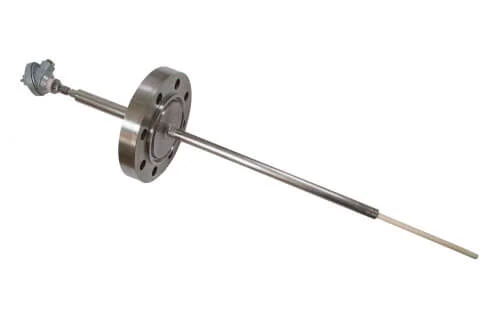Case Studies
Compost Temperature Sensors
Problem
Our customer manufactured peat free and chemical free compost from green & kitchen waste. The process required the material to reach a temperature of 65°C twice for at least two consecutive days. Therefore the temperature had to be measured accurately and controlled. The current suppliers temperature sensors had a high failure rate because of their poor design and manufacture, so the team had to come up with a cost effective solution.
Our Solution
We received the compost temperature sensors from our customer for repair. They were in various states and there was no clear design or standardisation. We were able to improve the design of the compost temperature sensor by including a flip top lid and pointed hot end. We decreased its failure rate through the application of a robust design.
Outcome
The customer had a tight budget so we didn’t replace all of their sensors at once. As the sensors needed repairing regularly, we brought them to the new specification one by one and documented the changes that had been made. The customer saw an instant reduction in the amount of failures and repairs needed only weeks after receiving the goods.

High temperature and pressure partial oxidisation plant (POX) probes
Problem
A major chemical manufacturer was experiencing repeated product failure of his current probes.
The key problems that were causing the failures, was the high pressure environment, and the high temperature of a vessel containing the reaction of partial oxidisation of natural gas to carbon monoxide (POX).
Temperature had to be measured in the highly reactive gaseous atmosphere to control the process and maintain plant safety. The probes had to last for a two-year plant rebuild cycle. The possibility of probe breakage due to furnace insulation movement had to be considered. The customer needed to be supplied full material, process control, testing and safety documentation.
Our Solution
A type B thermocouple was designed through collaboration with the client to contain pressure even with ceramic component failure.
The design consisted of a thick wall Recrystalised Alumina primary sheath with an Inconel alloy 600 support welded to a forged flange. Quality approved (ASME IX) welders were used. The B type conductors were routed through a multibore conax pressure gland, which provides containment at temperature. Each probe was double pressure tested. The first pressure test was on the metal work assembly with hydraulic oil at 106 bar and the second test was on the final assembly at 40 bar with blended air. We supplied a full set of documentation for each probe delivery.
A set of seven probes was installed which allow the plant to run for a two year campaign at which time the full set is always replaced.
Outcome
We were able to meet the specification given and the customer was satisfied with the goods we supplied. This contract has since been repeated many times over the years, again adding to our history of success and ability to delight customers.

Catalyst Tank Multipoint Thermocouple
Problem
A customer was having problems developing a novel reaction vessel. They needed to understand and control the processes occurring in a fluidised bed catalyst tank producing Vinyl Acetate Monomer (VAM). Spontaneous fires were rapidly degrading platinum catalysts. A significant plant life extension was urgently required.
The objectives were to produce a temperature sensor with up to 60 discrete measuring points with temperatures up to 300C throughout the vessel. The customer requested no thermowell to avoid temperature averaging and to increase probe flexibility. Probes were to be inserted through a flanged port and then routed around internal framework. Measuring tips were to be located at strategic points near oxygen spargers. At the tank entry, double sealing was required to contain the pressure and to provide the termination point for cable extension to the instrumentation.
Our Solution
Designing the double pressure containment was done in collaboration with the customer to meet the physical constraints as well as safety concerns.
Mineral insulated type K thermocouples were used with a double Hastelloy C276 sheath to withstand the acid. They were very flexible and easily bent with hands. The probes had an epoxy resin seal within the flange assembly as well as secondary compression fittings to hold the pressure. ASME IX coded welding was used. A bespoke termination enclosure was secured to the flange assembly and pre-wired to Multicore extension cable.
The 60 discrete sensors were all different predetermined lengths. The probes were pre-bundled according to the defined routes. All the probes were marked for easy identification in the uncomfortable working space of a catalyst tank. This made installation easier. They were secured to the internal framework and the measurement points could be placed exactly where the customer required with no averaging between probes whatsoever. We also provided some straightening rolls to deal with any kinks or bends that may occur. They were delivered in a degreased clean condition.
Outcome
Probes were delivered onto site ahead of schedule and within budget. They were fully documented for all tests and materials used. They were installed straight into the plant. A fault free performance has resulted in repeat orders from this particular client.
Aerospace Heat Treatment Thermocouple
Problem
Our customer needed to ensure that his furnace was meeting the requirements for high temperature heat treatment of aerospace engine components. It had to meet international standards to gain CAA (civil aviation authority) approval. The sensors had to be produced to an acceptable budget and meet end-user calibration schedules.
The temperatures were at the extreme top end of type K mineral insulated thermocouples. Very high temperature platinum based sensors may have been able to be repeatedly used but they are inflexible and the initial cost would be very high.
Our Solution
We provided an array of inexpensive single use mineral-insulated thermocouples, which had been calibrated to international standards. These sensors, up to 30M long, are routed from the load, through the furnace wall, to an instrument.
We had to maintain standards in producing a high-calibre furnace measurement system in a critical thermal control environment to timescale and budget. We were able to do this through careful sensor batch selection and supplier approval. Tight budgetary constraints were of the utmost importance throughout the project. Working closely with internal cost drivers and suppliers allowed all budgets to be achieved.
Outcome
The aerospace heat-treatment system was produced to agreed quality standards, within budget and to schedule. This generated a long-term collaborative relationship with regular repeat business.
Now the customer is able to provide certification of process-control procedures for aerospace components. Clearly, this high-safety critical process is vital for the aerospace industry.
Fault Free Temperature Sensors For Medical Use
Problem
An international medical firm required sensors for use in anaesthetic dispensing during surgical operations. They were developing equipment which ministered a mix of drugs crucial to the patient’s safety and well being during anaesthesia for surgery. They needed a set of probes to be installed in the dispenser.
Our Solution
In this case a set of three resistance thermometer probes was developed to meet the design criteria. There was a strong collaboration with the client using an open-book policy on all issues including costing. We agreed a manufacturing and test procedure to eliminate potential faults thus maintaining quality control in the long term. Statistical process control (SPC) techniques were utilised to ensure compliance within budget.
Working closely with our customer led to a strategy, which eliminated product failure and risk to the patient. Our manufacturing system analysis led to a rigorous procedure to ensure fault-free sensors were supplied ready for use without further customer testing.
This resulted in the customer producing a medical standards compliant solution. Throughout the ongoing product life cycle Peak Sensors has achieved a complaint-free status.
Challenges
Our challenges were to think creatively and to achieve a process that simplified the design of the temperature sensor and develop innovative production processes. We had to win the confidence of the customer early in the process.
Outcome
The relationship, with a fault-free product, has flourished resulting in long-term secure business.
Peak Sensors Helps Orientis Technology Improve Performance
Problem
Orientis Technology, a glass plant in Russia needed to improve its operation performance and quality output by reviewing and changing the temperature sensors within the regenerator of the plant.
Our Solution
The customer was changing its thermocouple temperature sensors within the glass plants regenerator every two weeks. This impacted on the glass plants operation performance, delivery and costs. It included the customer spending time and effort changing the probes regularly. Which also lead to increased plant costs for the purchase of the number of thermocouples needed for these frequent changes.
The glass plant with the support of our Russian agent Orientis Technology and Peak Sensors technical team identified areas of improvement with the thermocouple design within the regenerator and developed rare metal thermocouple probes with a ceramic sheath to better suit the glass plant leading to improved performance, quality and reduced costs.
Submit an Enquiry
"*" indicates required fields
